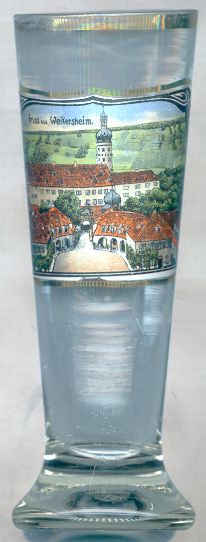

|
| DEUTSCHLAND | GERMANY |
| Bundesland: Baden-Württemberg | |
| Regierungsbezirk: Stuttgart | |
| Landkreis: Main-Tauber-Kreis |
 Weikersheim is situated at an elevation of 296 m on the river Tauber in northeast Baden-Württemberg.
"Wighartesheim" was first mentioned in AD 837 in a deed of donation of the monastery of Fulda.
The Lords of Weikersheim, who from 1178 called themselves Hohenlohe, were first mentioned in 1153.
In 1313 Weikersheim obtained the status of a town and with that also the right to hold markets and to build a town wall. During the
following centuries the Hohenlohe family frequently split into several lines. Between the end of the 16th and the mid-18th century, however,
Weikersheim evolved into a splendorous princely residence. In 1806 the former Principality of Hohenlohe lost its sovereignty and
Weikersheim became part of the new Kingdom of Württemberg.
Even today the city is still marked by numerous buildings of the
Renaissance and Baroque periods.
Weikersheim is situated at an elevation of 296 m on the river Tauber in northeast Baden-Württemberg.
"Wighartesheim" was first mentioned in AD 837 in a deed of donation of the monastery of Fulda.
The Lords of Weikersheim, who from 1178 called themselves Hohenlohe, were first mentioned in 1153.
In 1313 Weikersheim obtained the status of a town and with that also the right to hold markets and to build a town wall. During the
following centuries the Hohenlohe family frequently split into several lines. Between the end of the 16th and the mid-18th century, however,
Weikersheim evolved into a splendorous princely residence. In 1806 the former Principality of Hohenlohe lost its sovereignty and
Weikersheim became part of the new Kingdom of Württemberg.
Even today the city is still marked by numerous buildings of the
Renaissance and Baroque periods.
The Renaissance  Hohenlohe residence castle [left] was created in 1587 out of an older moated castle
by Count Wolfgang II of Hohenlohe whose father, Wolfgang I, had introduced the Reformation in Weikersheim in 1541.
In 1634 the town and the castle were looted by Bavarian troops. The stables were built in 1679. At the same time the tall keep
received its characteristic domed roof. In 1708/09 Weikersheim became the residence of Carl Ludwig of Hohenlohe-Weikersheim who
immediately began to build what became known as the "Hohenlohe Versailles" with its splendid early Baroque park, orangery,
hunting lodge and summer residence.
Hohenlohe residence castle [left] was created in 1587 out of an older moated castle
by Count Wolfgang II of Hohenlohe whose father, Wolfgang I, had introduced the Reformation in Weikersheim in 1541.
In 1634 the town and the castle were looted by Bavarian troops. The stables were built in 1679. At the same time the tall keep
received its characteristic domed roof. In 1708/09 Weikersheim became the residence of Carl Ludwig of Hohenlohe-Weikersheim who
immediately began to build what became known as the "Hohenlohe Versailles" with its splendid early Baroque park, orangery,
hunting lodge and summer residence.
![[scale]](lineal.jpg)